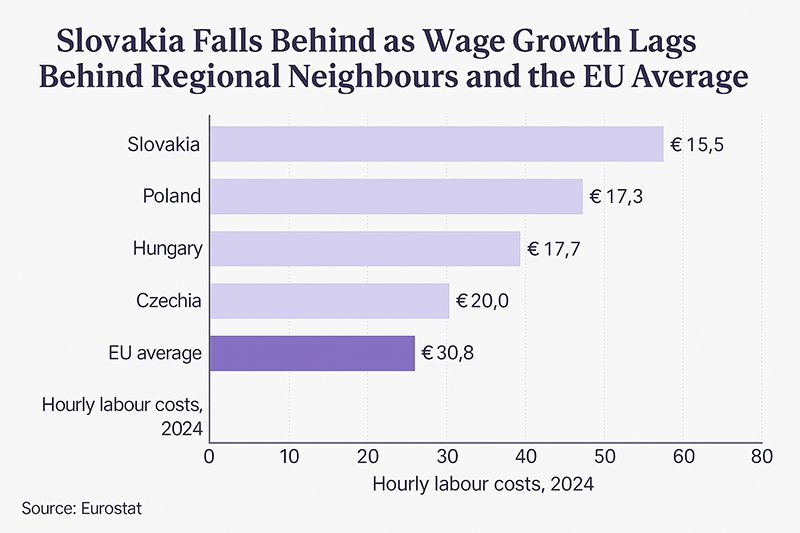Slovakia falls behind as wage growth lags behind regional neighbours and the EU average
Salary growth in Slovakia continues to trail not only the wealthier nations of Western Europe but also some of its closest Central and Eastern European neighbours, raising concerns about the country’s long-term competitiveness and ability to retain skilled workers. While Slovaks grapple with stagnant wages and rising costs of living, other countries in the region—particularly Poland and Austria—are seeing wages rise at a much faster pace, widening the income gap even further.
The contrast is most striking when compared with neighbouring Austria, where wages are not only significantly higher but are also growing more rapidly. The disparity between the two economies has become increasingly difficult to ignore for Slovak workers, especially those living near the border or commuting daily to Austria for better-paid jobs. According to recent Eurostat data, Austria remains among the top performers in wage growth within the European Union, offering a level of income and living standards that Slovakia is struggling to match or catch up with.
Across the EU, wage costs per hour show stark differences between member states. At the top of the list is Luxembourg, where companies paid an average of €55.20 per hour worked in 2024. The country, known for its thriving financial sector and favourable tax environment, has attracted a concentration of international banks, insurance providers, and investment firms, which in turn contributes to its exceptionally high wage levels. Luxembourg’s competitiveness in finance has driven up salaries in that sector and, by extension, across its broader economy.
At the other end of the spectrum, companies in Bulgaria paid an average of only €10.60 per hour last year. The Bulgarian economy, heavily reliant on tourism, is subject to seasonal fluctuations and a high proportion of low-wage employment. Unlike Slovakia, Bulgaria lacks a significant industrial base, particularly in automotive manufacturing, which often drives higher wage sectors in Central Europe. The absence of large industrial employers has contributed to an ongoing outflow of skilled Bulgarian workers seeking better pay abroad.
Even among post-communist EU members, Slovakia is not keeping pace. Slovenia, long considered the most successful of the former Eastern Bloc countries in terms of economic transformation, reported average hourly labour costs of €27.10—more than double Slovakia’s figures. Slovenia’s wage levels have now surpassed those in Spain (€25.50), Malta (€19.10), and Portugal (€18.20), countries with longer EU membership and more developed social safety nets.
Brussels remains aware of these disparities and continues to channel cohesion funds toward newer member states to help close the gap. These funds have been critical in supporting infrastructure, healthcare, and education in countries like Poland, where smart allocation of EU resources has driven substantial development. Poland has invested heavily in roads, railways, hospitals, and research parks—projects that have both improved public services and increased the country’s economic appeal to returning professionals.
This strategic use of European funds has also bolstered Poland’s labour market. As of 2024, Poland reported the fastest wage growth in the European Union, with average hourly pay rising by 19 percent year-on-year to €17.30. This remarkable performance not only signals a stronger domestic economy but also reflects a successful model of wage growth that hasn’t deterred private sector competitiveness. The increase comes amid a continent-wide labour shortage, with Polish employers proving capable of managing higher labour costs while maintaining business viability.
In Slovakia, by contrast, wage growth remains tepid. Despite a relatively strong industrial base—particularly in the automotive sector—the country has yet to see substantial gains in real wages for workers across key sectors. Many experts attribute this to structural issues in the labour market, a lack of investment in high-value industries, and insufficient innovation in wage-setting practices. Additionally, slower wage growth may discourage talent retention, with younger and more skilled workers increasingly eyeing opportunities abroad.
The consequences of slow wage growth extend beyond economic frustration. Slovakia risks deepening its dependency on external labour markets while losing domestic productivity. With inflation putting additional pressure on household budgets, the urgency for meaningful wage reform is growing.
As Poland and other regional peers continue to surge ahead, the message is becoming clear: catching up will require more than just economic stability—it demands a coordinated national strategy focused on wage competitiveness, innovation, and effective use of EU development tools. Without decisive action, Slovakia may find itself increasingly isolated in a fast-converging European economy.
Source: Eurostat









